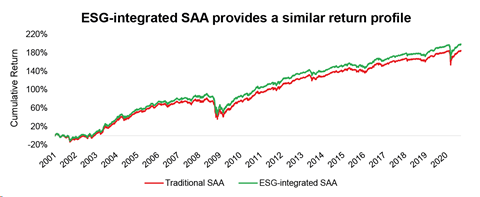Case study by BlackRock
For professional clients and qualified investors only
- Signatory type: Investment manager
- Region of operation: Global
- Assets under management: US$7.8trn (30 September 2020)
Why incorporate esg considerations into a strategic asset allocation (SAA)?
Using multi-asset allocations to help clients achieve the growth they require at reasonable risk and across market environments has historically been a purely financial goal. Now, however, investors are increasingly looking to incorporate environmental, social and governance (ESG) considerations into their portfolios. A growing understanding of how sustainability risks affect economic growth, asset values and financial markets is likely to accelerate that trend.
Efficiently balancing sustainability outcomes with risk and return objectives can be a challenge, especially in a multi-asset context. We believe that using well-established return drivers (factors) can be an attractive way to meet both goals. We use a factor-informed strategic asset allocation to combine exposure to macro-economic factors with an ESG improvement target and an explicit reduction in carbon emissions.
We also find that clients are increasingly using exclusionary screens to avoid exposure to certain companies or sectors that pose reputational risks or violate certain values. We therefore incorporate a series of screens to this allocation that address the majority of clients’ requests for these exclusions, covering sectors such as fossil fuels, controversial weapons and tobacco.
Apply exclusionary screens to align with investors’ values and potentially enhance long-term returns or reduce risk

Whilst maintaining our full desired factor exposure and risk and return characteristics, our analysis suggests that it is possible to achieve a 20%-30% improvement in ESG scores and a 50% reduction in carbon emissions intensity relative to a traditional allocation.
The achieved reduction in carbon emissions intensity is particularly meaningful, enabling investors to start mitigating the regulatory, reputational and financial risks associated with exposure to high carbon emitting assets.
Source: BlackRock, September 2020. The environmental, social and governance (“ESG”) considerations discussed herein may affect an investment team’s decision to invest in certain companies or industries from time to time. Results may differ from portfolios that do not apply similar ESG considerations to their investment process. For illustrative purposes only.
How we incorporate ESG considerations into a SAA
We believe we can summarise the movements of global asset class returns with common (macro) factors. These macro factors have three fundamental characteristics: (1) they help explain the majority of the variability in asset class returns; (2) historically, they have been rewarded over long-term investment horizons due to an undiversifiable risk premium; and (3) they are economically intuitive.
We find that, across multiple asset classes, six fundamental macro-economic factors explain the majority of asset class variability: economic, real rates, inflation, credit, emerging markets and liquidity. To construct a factor-led SAA, each macro factor is modelled by identifying an intuitive, investable, factor-mimicking portfolio that provides relatively isolated exposure to the macro factor. To do this we use highly liquid and index-like investment instruments across multiple asset classes.
In our view, incorporating sustainability into the macro factor approach, which has risk management at its heart, is a natural and logical extension. The challenge is to do this in a way that:
- does not compromise financial return goals;
- limits the level of additional active risk;
- achieves significant improvement in ESG scores;
- explicitly targets a substantial reduction in carbon emissions intensity (in line with our belief that climate risk now constitutes a structural, long-term investment risk).
Example: building an ESG-integrated SAA
With the instruments currently available, we observe that we can replace core equity and corporate credit exposures with indices that are ESG ‘optimised’: seeking to maximise the ESG profile while closely tracking parent indices. This includes developed market equities (both large and small cap), investment grade and high yield credit and emerging market securities (both equities and debt). We also note that it is possible to replace cash exposure with more environmentally aware money market funds.
For some asset classes, most notably property and commodities, there are, as yet, no satisfactory substitutes, in our view. For example, investing in green properties is possible but it remains a niche area with a lack of sufficiently liquid, index-like vehicles.
In some asset classes, most notably equities, there is the potential for the additional benefit of investment stewardship – actively helping to promote sound corporate governance and business practices. These stewardship activities focus on board quality, environmental risks and opportunities, corporate strategy and capital allocation, compensation that promotes long-termism and human capital management.
In the chart below, we show a simulation of how an ESG-integrated factor-informed SAA could have performed versus a standard factor iteration.

Source: BlackRock. Simulated returns Dec-00 to Sep-20. The figures shown relate to past performance. Past performance is not a reliable indicator of current or future results and should not be the sole factor of consideration when selecting a product or strategy. The value of an investment can fall as well as rise and the investor may not get back the original amount invested. There is a risk that the entire amount invested may be lost. BlackRock makes no representations or warranties as to the accuracy or completeness of any past, estimated or simulated performance results contained herein, and further nothing contained herein shall be relied upon as a promise by, or representation by BlackRock whether as to past or future performance results. For illustrative purposes only.
We believe the simulated results of the ESG-integrated SAA compared to a standard approach are encouraging; the inclusion of ESG and carbon emissions reduction goals does not come at the expense of sacrificing returns, based upon historical performance. This appears to hold true over time, with the ESG-integrated allocation demonstrating more muted drawdowns in periods of stress, such as in 2008 and 2020. We observe some divergence in risk between both portfolios during the early periods, as expressed by the tracking error of the sustainable allocation relative to its traditional counterpart. However, this was largely due the limited availability of sustainable building blocks at that time. Since then, risk levels have largely converged reflecting the emergence and evolution of these sustainable building blocks that provide the asset class exposure that is required in a macro factor allocation.
And, crucially, our ESG strategic asset allocation also meets the sustainability test. It provides a significantly improved ESG profile, +20%, as well as a major reduction in carbon emissions intensity, -50%.
DISCLAIMER
This case study is for illustrative purposes only; it is not meant as a guarantee of any future results or experience and should not be interpreted as advice or a recommendation. Reference to individual investments mentioned in this communication is for illustrative purposes only and should not be construed as investment advice or investment recommendation.
All charts are for illustrative purposes only. This is not a recommendation by BlackRock to adopt any particular investment strategy. Indexes are unmanaged and used for illustrative purposes only and are not intended to be indicative of any fund’s performance. It is not possible to invest directly in an index. Past performance is not indicative of future results. Case studies are edited by the PRI for clarity and consistency. This material is for distribution only to those types of recipients as provided and should not be relied upon by any other persons. This material is provided for informational purposes only and does not constitute a solicitation in any jurisdiction in which such solicitation is unlawful or to any person to whom it is unlawful. Moreover, it neither constitutes an offer to enter into an investment agreement with the recipient of this document nor an invitation to respond to it by making an offer to enter into an investment agreement.
This material is not intended to be relied upon as a forecast, research or investment advice, and is not a recommendation, offer or solicitation to buy or sell any securities or to adopt any investment strategy.













